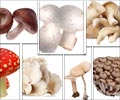Researchers at the Michigan State University have identified a genetic trait common to a few species of mushrooms that produces toxins and is responsible for almost all mushroom-eating deaths.
Alpha-amanitin is the poison of the death cap mushroom, Amanita phalloides. Heather Hallen, plant biology research associate at the University was looking for a big gene that makes a big enzyme that produces alpha-amanitin, since that’s how other fungi produce similar compounds. But after years of defeat, she and her team called in the big guns i.e. a new technology that sequences DNA about as fast as a death cap mushroom can kill.They discovered remarkably small genes that produce the toxin, a unique pathway previously unknown in fungi.
According to the authors, it is a work that not only solves a mystery of how some mushrooms make the toxin – but also explains the underlying biochemical machinery. It might be possible one day to harness the mushroom genes to make novel chemicals that would be useful as new drugs, the say.
“We think we have a factory that spits out lots of little sequences to make chemicals in Amanita mushrooms. Our work indicates that these mushrooms have evolved a mechanism to make dozens or even hundreds of new, previously unknown chemicals, besides the toxins that we know about,” said Jonathan Walton, MSU plant biology professor who leads Hallen’s team.
Of the thousands of species of mushrooms, only about 30 produce alpha-amanitin. Alpha-amanitin kills people by inhibiting an enzyme necessary for expression of most genes. Without the ability to synthesize new proteins, cells quickly grind to a halt. The intestinal tract and the liver are the hardest hit as they come into first contact with the toxin. By the time symptoms show up, a liver transplant is often the only hope.
Hallen, a mycologist, gathers mushrooms in the Michigan woods and often is called upon to help identify mushroom species for veterinarians, parents of small children and local hospitals – often in a desperate race to beat alpha-amanitin’s effects.
Advertisement
What they found was a gene that encodes the toxin directly – with no need to first synthesize an enzyme that in turn would make the toxin. “The RNA goes in, and out comes the backbone of the toxin,” Hallen said.
Advertisement
Hallen and Walton also believe that their finding could pave way for a diagnostic test that could use DNA to determine if a mushroom is toxic or not. Identifying a mushroom by shape and color alone is often impossible if the mushroom has been cooked or partially digested, yet rapid and accurate identification in an emergency room situation is critical.
The research is published in Proceedings of the National Academy of Sciences.
Source-ANI
LIN/P











